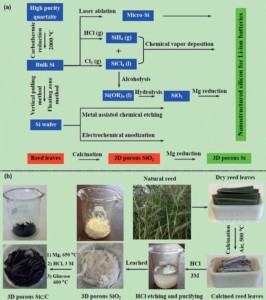A low-cost approach to fabricating nanoporous silicon — a potentially highly useful material for next-generation anode material in batteries, owing to assumed greater capacity and lowered operating voltage — has been developed by researchers at Max Planck Institute for Solid State Research, the University of Science and Technology of China, and the South China University of Technology.
The new approach, interestingly, doesn’t rely on exotic chemicals or processes, but rather simply uses reed leaves (from the common plant), which can be transformed via simple calcination + magnesiothermic reduction.

The silicon anode that results features the 3-D hierarchical architecture of the reed leaf — as well as an interconnected porosity + internal carbon coating. This material shows “high specific capacity, very good rate capability, and cycling stability, just as it is required in advanced lithium-ion batteries. Even after 4,000 cycles and at a rate of 10C, the anode achieved a specific capacity of 420 mAhg-1.”
Here are some excerpts from a paper on the work:
… As a living plant, reeds absorb silica from soil, and the silica accumulates around cellulose microcompartments. Therefore, reeds are suitable natural reservoirs of nano-structured silica and its derivatives. Yet they are not only appropriate Si sources, they also contain silica in a very favorable nanoscale arrangement.
… reed leaves exhibit well-defined sheet-like 3D hierarchical micro- structures, which as we demonstrate can be transformed into a well-suited 3D highly porous hierarchical Si architectures.
…The topological architecture of the original silicates within the reed leaves is extraordinarily well preserved during the applied chemical and physical treatment steps. Upon the purification from the dry reed leaves, the three-dimensional structure only shrinks, but retains its mesoporous network. It does not even change during the reduction to the final carbonized silicon network.
…given the sustainable and facile nature of the synthesis procedure, the described 3D porous Si-C nanocomposite has a great potential as a practical anode material for Li-ion batteries.
The new work is detailed in a paper published in Angewandte Chemie International Edition.
Image via Max Planck Institute for Solid State Research, the University of Science and Technology of China, and the South China University of Technology
Keep up to date with all the hottest cleantech news by subscribing to our (free) cleantech newsletter, or keep an eye on sector-specific news by getting our (also free) solar energy newsletter, electric vehicle newsletter, or wind energy newsletter.
CleanTechnica, 2015-07-27, http://cleantechnica.com/2015/07/27/high-performance-3-d-silicon-anodes-made-reed-leaves/